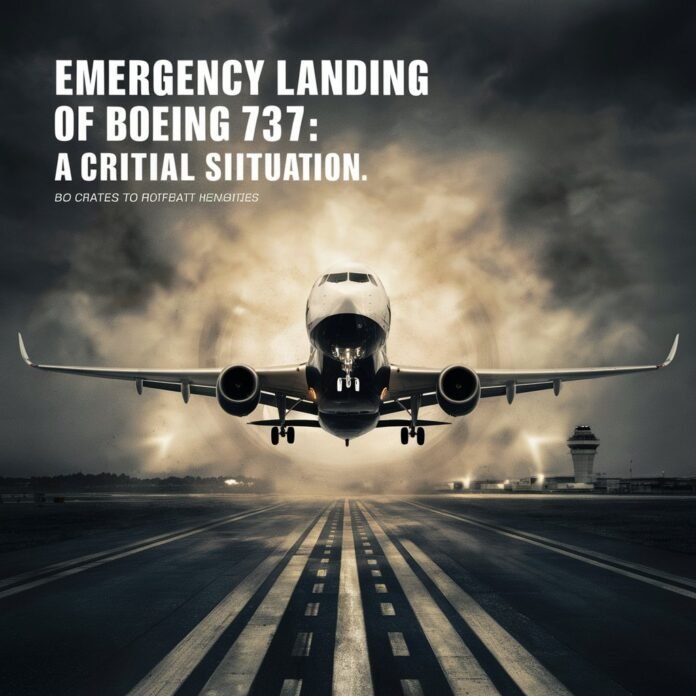Table of Contents
- Introduction to Emergency Landings
- Understanding Emergency Landings
- 2.1 What is an Emergency Landing?
- 2.2 Why Do Emergency Landings Occur?
- Types of Emergency Landings
- 3.1 Engine Failure
- 3.2 Decompression
- 3.3 Mechanical Issues
- 3.4 Fuel Shortages
- The Emergency Landing Process
- 4.1 Procedures for Pilots
- 4.2 Passenger Safety
- 4.3 Communication with Air Traffic Control
- Case Studies
- 5.1 The Boeing 737 Incident in Milwaukee
- 5.2 Famous Emergency Landings
- Impact of Emergency Landings on Passengers and Crew
- 6.1 Psychological Effects
- 6.2 Physical Safety
- How Airlines and Airports Prepare for Emergency Landings
- 7.1 Training for Crew and Ground Staff
- 7.2 Safety Equipment and Protocols
- The Role of Technology in Emergency Landings
- 8.1 Advances in Aircraft Technology
- 8.2 Communication and Navigation Systems
- Future Trends and Improvements in Emergency Landing Procedures
- Frequently Asked Questions (FAQs)
- Conclusion: The Importance of Preparedness and Safety
1. Introduction to Emergency Landings
Emergency landings are critical events that occur when an aircraft needs to land unexpectedly due to a problem that could compromise safety. These situations are rare but highly significant, as they test the preparedness and response of both the crew and the passengers. This comprehensive guide will delve into the various aspects of emergency landings, including the procedures involved, real-life case studies, and the advancements in technology that help ensure safety.
The Boeing 737 carrying Vance declared an emergency shortly after departing from Milwaukee and returned to the airport for repairs.
2. Understanding Emergency Landings
2.1 What is an Emergency Landing?
An emergency landing is a maneuver where an aircraft is brought down in an unplanned location or in a manner that deviates from its original flight plan due to unforeseen issues. This could be due to a mechanical failure, sudden health emergencies, or external factors like severe weather conditions.
2.2 Why Do Emergency Landings Occur?
Emergency landings can occur for a variety of reasons, including but not limited to:
- Engine Failure: A critical problem with one or more engines.
- Decompression: A sudden loss of cabin pressure.
- Mechanical Issues: Problems with the aircraft’s systems or structure.
- Fuel Shortages: Running low or out of fuel.
- Medical Emergencies: Serious health issues among passengers or crew.
3. Types of Emergency Landings
3.1 Engine Failure
Engine failure is one of the most serious situations that can lead to an emergency landing. Modern aircraft are designed to handle such emergencies, but they still require swift and precise action from the pilots. Pilots are trained to perform emergency landings in such scenarios, often using the remaining engines or gliding to a safe landing.
3.2 Decompression
Decompression occurs when there is a loss of cabin pressure, which can lead to hypoxia (lack of oxygen) among passengers and crew. In such cases, the aircraft must descend to a lower altitude where the air is breathable. Emergency oxygen masks are provided to ensure safety until the plane can land.
3.3 Mechanical Issues
Mechanical issues can range from problems with the landing gear to failures in critical systems like navigation or communication. Aircraft are equipped with various backup systems and procedures to handle these issues and safely land the plane.
3.4 Fuel Shortages
Running out of fuel is a critical emergency that can occur due to several reasons, including navigation errors or fuel leaks. Pilots must act quickly to find the nearest suitable airport or emergency landing site.
4. The Emergency Landing Process
4.1 Procedures for Pilots
Pilots follow a series of well-defined steps during an emergency landing:
- Assessment: Evaluate the situation and determine the nature of the emergency.
- Communication: Inform air traffic control and declare an emergency.
- Navigation: Plan the safest route to the nearest suitable airport or landing site.
- Preparation: Prepare the aircraft and passengers for landing, including a briefing on safety procedures.
- Execution: Perform the landing with utmost precision and follow post-landing protocols.
4.2 Passenger Safety
Passenger safety is paramount during an emergency landing. The crew will guide passengers through the safety procedures, including the use of oxygen masks, seatbelt fastening, and brace positions. Keeping calm and following instructions are crucial for ensuring safety.
4.3 Communication with Air Traffic Control
Effective communication with air traffic control (ATC) is essential for a successful emergency landing. ATC provides crucial support, including clearing the runway, guiding the aircraft to a safe landing, and coordinating with emergency services.
5. Case Studies
5.1 The Boeing 737 Incident in Milwaukee
In a notable incident involving a Boeing 737, the aircraft declared an emergency shortly after departing from Milwaukee due to a mechanical issue. The plane returned to the airport safely for repairs, demonstrating the effectiveness of emergency protocols and the skill of the flight crew. This incident highlights the importance of prompt action and clear communication in managing emergencies.
5.2 Famous Emergency Landings
- Flight 1549 (The Miracle on the Hudson): In 2009, US Airways Flight 1549 made an emergency landing on the Hudson River after both engines failed. The incident was widely praised for the crew’s exceptional handling and the quick response of emergency services.
- Air France Flight 296: In 1988, this flight had to make an emergency landing due to a malfunction. The incident led to a major review of safety procedures and aircraft design improvements.

6. Impact of Emergency Landings on Passengers and Crew
6.1 Psychological Effects
Emergency landings can be traumatic for passengers and crew, leading to stress, anxiety, and post-traumatic stress disorder (PTSD). Support services and counseling are often provided to help individuals cope with the psychological impact.
6.2 Physical Safety
In most cases, emergency landings are executed safely with minimal physical harm. However, there may be injuries related to the landing process, such as during the evacuation or turbulence. Medical evaluations and assistance are provided as needed.
7. How Airlines and Airports Prepare for Emergency Landings
7.1 Training for Crew and Ground Staff
Airlines and airports invest heavily in training programs for pilots, crew members, and ground staff. Training includes simulated emergency scenarios, hands-on practice with safety equipment, and coordination with emergency services.
7.2 Safety Equipment and Protocols
Aircraft are equipped with a variety of safety features, including emergency oxygen systems, fire suppression equipment, and life vests. Airports also have dedicated emergency response teams and facilities to handle incidents effectively.
8. The Role of Technology in Emergency Landings
8.1 Advances in Aircraft Technology
Modern aircraft are equipped with advanced technology to handle emergencies, such as enhanced navigation systems, automated safety alerts, and improved engine reliability. These advancements contribute to safer and more efficient emergency landings.
8.2 Communication and Navigation Systems
Advanced communication and navigation systems allow pilots to stay in constant contact with air traffic control and receive real-time updates on weather conditions and available landing sites. This technology plays a crucial role in managing emergency situations.
9. Future Trends and Improvements in Emergency Landing Procedures
9.1 Innovations in Aircraft Design
Future aircraft designs will likely include even more sophisticated safety features and automation to assist with emergency landings. Innovations may include advanced landing gear systems, improved glide capabilities, and enhanced emergency response systems.
9.2 Enhanced Training Programs
Training programs for pilots and crew will continue to evolve, incorporating new technologies and simulation techniques. This will ensure that personnel are well-prepared to handle a wide range of emergency scenarios.
9.3 Increased Focus on Passenger Safety
Future improvements will focus on enhancing passenger safety and comfort during emergencies. This may include better evacuation procedures, more effective safety briefings, and innovations in emergency equipment.
10. Frequently Asked Questions (FAQs)
Q1: What is an emergency landing?
An emergency landing is an unplanned landing of an aircraft due to unforeseen issues such as mechanical failure, engine problems, or medical emergencies.
Q2: Why do emergency landings happen?
Emergency landings occur due to various reasons, including engine failure, decompression, mechanical issues, fuel shortages, or medical emergencies.
Q3: How do pilots prepare for an emergency landing?
Pilots assess the situation, communicate with air traffic control, plan the safest route, prepare the aircraft and passengers, and execute the landing with precision.
Q4: What should passengers do during an emergency landing?
Passengers should follow the crew’s instructions, use oxygen masks if needed, fasten seatbelts, and assume the brace position as directed.
Q5: How does technology help in emergency landings?
Technology assists with advanced navigation systems, communication with air traffic control, and automated safety features to improve the effectiveness of emergency landings.
Q6: What are the psychological effects of emergency landings?
Emergency landings can cause stress, anxiety, and PTSD. Support services and counseling are provided to help individuals cope with these effects.
Q7: What are some famous emergency landings?
Notable examples include US Airways Flight 1549, which landed on the Hudson River, and Air France Flight 296, which led to significant safety improvements.
11. Conclusion: The Importance of Preparedness and Safety
Emergency landings are critical events that require careful planning, precise execution, and effective communication. The advancements in technology, rigorous training programs, and comprehensive safety protocols all contribute to the effectiveness of emergency landing procedures. By understanding the various aspects of emergency landings and the measures taken to ensure safety, we can appreciate the complexity and importance of aviation safety.




